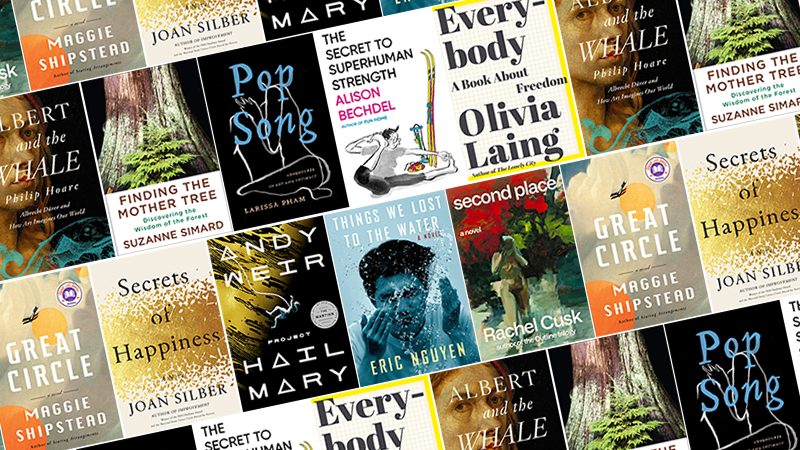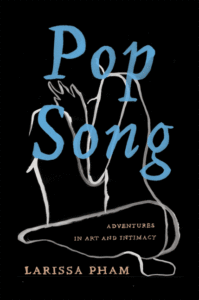
Rachel Cusk’s Second Place, Andy Weir’s Project Hail Mary, Alison Bechdel’s The Secret to Superhuman Strength, and Olivia Laing’s Everybody all feature among the Best Reviewed Books of the Week.
1. Second Place by Rachel Cusk
(FSG)
13 Rave • 8 Positive • 1 Mixed
Listen to an interview with Rachel Cusk here
“You know when you’re reading a page of Rachel Cusk’s fiction. Her narrators tug insistently if coolly at the central knots of being. They analyze every emotion as if it were freshly invented. Nothing is extraneous … The narrator is familiar: a sharply observant writer in middle age … More notably, this book has a swirling hothouse quality that’s new … It’s as if Cusk has been reading Joyce Carol Oates’s best novels. She digs into the gothic core of family and romantic entanglements. I filled the margins with check marks of admiration, but also with exclamation points. This novel pushes its needles into the red … One doesn’t come to a Cusk novel for plot but for her extra-fine psychological apparatus. Yet there is a fair amount of plot in Second Place … If I could have rubbed a lamp and lightened this book’s lurid intensities, I might have. It is not a novel that gladdens the soul. But gladdening the soul has never been Cusk’s project.”
–Dwight Garner (The New York Times)
2. Great Circle by Maggie Shipstead
(Knopf)
10 Rave • 2 Positive • 1 Mixed
Listen to an interview with Maggie Shipstead here
“…a relentlessly exciting story about a woman maneuvering her way between tradition and prejudice to get what she wants. It’s also a culturally rich story that takes full advantage of its extended length to explore the changing landscape of the 20th century … A novel that switches between two different periods and tones confronts the essential challenge of rendering both competing story lines engaging, and Great Circle struggles to make that case. Hollywood, with all its hypocrisy and excess, may be a fat target, but it’s also a tattered one, and Shipstead has far more success bringing 1914 to life than 2014. The extraordinary realism of Marian’s chapters can make the broad strokes of Hadley’s sections feel light in comparison … But fortunately, when Hadley gets serious about discovering the real story of Marian, the novel’s parallel stories begin to resonate with each other in interesting ways. Though separated by decades, the aviator and the actress are both powerful women, rising from devastating tragedies to forge their own way … Whether you’re planning a trip or settling in for a staycation, Great Circle is my top recommendation for this summer.”
–Ron Charles (The Washington Post)
3. Secrets of Happiness by Joan Silber
(Counterpoint)
9 Rave • 3 Positive • 1 Mixed
Read an excerpt from Secrets of Happiness here
“Her most interesting characters are alert to the main chance, nursing various degrees of larceny in their hearts; while the more sympathetic—if less interesting—ones have grasped the paltriness of a life dedicated to getting and spending. In the seven artfully linked stories of Ms. Silber’s new novel…we find both types, but once again those who display the will to be canny, which money in the offing or in the pocket seems to confer, are the most deeply penetrated and superbly conjured … Each of the seven sections engages our interest right off the bat; each has a first sentence pregnant with promise … Having seized our attention, Ms. Silber pushes forward into her characters’ stories, summing up in fleet, fluid prose the circumstances and acts that have shaped their lives to this point, then slipping deftly into further events where, for better or worse, the gravitational force of money can be felt … Despite their unity of theme, Ms. Silber’s stories are the furthest thing from didactic … they are rich with the complexities of life; the characters’ motives and their decisions arise out of personalities meeting circumstance. Further, the stories create a world made fully dimensional through changes of perspective—major characters appear and reappear as part of one or another’s experience and testimony … It is a fine thing, subtly done, and truly exhilarating.”
–Katherine A. Powers (The Wall Street Journal)
4. Project Hail Mary by Andy Weir
(Ballantine)
6 Rave • 1 Positive • 1 Mixed
“… the modern sci-fi master sends a lone astronaut on an intergalactic mission with existential stakes and a winning sense of humor … a complex, science-filled story that’s also about empathy and friendship found in the most unlikely of places … Weir’s parallel story line structure mostly works … The beginning backstory and later revelations about the days leading up to launch are essential and clever bits of character development, though in the middle of the book, the past sometimes disrupts the momentum of Ryland and Rocky’s team-building exercises and bonding as ride-or-die science bros … if you dug Weir’s original self-published hit or the Oscar-nominated Matt Damon film, get ready to enjoy this, too. Weir’s well-crafted book is an epic story of redemption, discovery and cool speculative sci-fi made all the better with a couple of perfect strangers turned BFFs.”
–Brian Truitt (USA Today)
5. Things We Lost to the Water by Eric Nguyen
(Knopf)
6 Rave
Read an excerpt from Things We Lost to the Water here
“While the story arc might sound familiar—other-side-of-the-world refugees who endure challenging lives in the U.S.—Nguyen’s gentle precision nevertheless produces an extraordinary debut with undeniable resonance … Once upon a time, Hương was a village wife to teacher Công, mother to young Tuấn. Suddenly, all three are running for their lives, but only Hương and Tuấn board the boat, embarking on a path of everlasting separation … Nearly three decades later, Hurricane Katrina will once again confront the trio with Things We Lost to the Water and the question of what can and should be salvaged from the devastation.”
–Terry Hong (Booklist)
**

1. Pop Song: Adventures in Art and Intimacy by Larissa Pham
(Catapult)
9 Rave • 1 Mixed
“Pham’s collection boldly reinterprets the memoir-essay genre by accompanying her stories of love with ekphratic commentary on the visual, aural, and verbal language of intimacy. This oblique, innovative method is the author’s makeshift solution to the problem she poses in the collection of how to write on intimacy. Through this form of ekphrasis, she is able to give texture to surface-level events and feelings, as well as to map out her own unique artistic sensibility … Pham’s absorption with the collection of vessels of intimacy, most explicitly represented by photographs of her and her boyfriend, is motivated by a fear of losing that intimacy, of loss of love. She repeatedly resorts to artifice and performance to construct a narrative of her relationship that preserves intimacy despite its infidelity to reality. If there is a coming-of-age for Pham in this textured, meditative book, then it lies in the shedding of artifice.”
–Darren Huang (Full Stop)
2. The Secret to Superhuman Strength by Alison Bechdel
(Houghton Mifflin Harcourt)
6 Rave • 5 Positive
“Drawing is often seen as a cartoonist’s primary skill, but Bechdel can also really write. The various strings of her narrative are woven together in a way that feels fresh, clever and moving. There is also dry humour … Her conclusion is inevitably trite, but Bechdel makes for such a likeable protagonist that readers will be pleased for her all the same. And while this book might not be the author’s most gripping work, it is probably her most beautiful, being the first to have been rendered in full colour … Bechdel’s work is elegant and literary in a way that people don’t expect from graphic books. If you haven’t read anything by her yet, it’s a good time to catch up.”
–Lucy Knight (The Sunday Times)
3. Everybody: A Book About Freedom by Olivia Laing
(W. W. Norton & Company)
7 Rave • 1 Mixed
“Laing steadily built her reputation as an editor and writer with an earnest sophistication. She doesn’t make her mark with arch observations or cool reserve. Her enthusiastic criticism is fueled by a political and humane connection as well as an aesthetic and intellectual one … Everybody concentrates with exuberance on bodies as a means to riddle out the expression and performance of freedom. Through protest, suppression, illness, sex, and movement, human bodies are a battleground for freedom … Through careful study of the lives and deaths of artists and activists such as Susan Sontag, Kathy Acker, Christopher Isherwood, Andrea Dworkin, Malcolm X, Bayard Rustin, and Nina Simone, Laing uncovers Reich’s influence beyond his lifetime into the civil rights movement as well as the gay and sexual liberation movements of the 20th century … What surfaces are the mechanisms of shame and glory that inform radical engagement … Dreaming beyond conventional wisdom and restrictive visions, Laing emboldens us to seek liberation across difference in the face of turmoil. Everybody is a galvanizing book during a time of incredible hesitation.”
–Laure LeBlanc (The Boston Globe)
4. Albert and the Whale: Albrecht Dürer and How Art Imagines Our World by Philip Hoare
(Pegasus Books)
5 Rave • 3 Positive • 1 Mixed
“… dreamy … Hoare’s way has always been to swim with the currents he catches, and Dürer’s biography ends up generously spliced with entertaining digressions and unexpected but illuminating juxtapositions … Before long, in his typically allusive and impish style, Hoare has unfurled a whole tapestry of lives connected, however loosely, to Dürer’s work and its themes … Barriers of time and place are irradiated by the power of Hoare’s vision … We are soon immersed in Lake Hoare. His eschewal of quotation marks blurs the distinction between voices. We’re often unsure if he’s recalling his own experiences or reinscribing those of others. His passionately personal engagement with his idols is all the more persuasive for these attempts to merge with them; there is no facade of critical dispassion … While some readers may struggle to stay afloat in this sea of glinting references and wandering currents, others will be happy to join Hoare in his diving bell to revelation … From their lives and works, he extrapolates an entire cosmology, a way of seeing the world every bit as rich and penetrating as Dürer’s.”
–Charles Arrowsmith (The Washington Post)
5. Finding the Mother Tree: Discovering the Wisdom of the Forest by Suzanne Simard
(Knopf)
4 Rave • 2 Positive
“In her new book, Simard contends that at the center of a healthy forest stands a Mother Tree: an old-growth matriarch that acts as a hub of nutrients shared by trees of different ages and species linked together via a vast underground fungal network. Her argument is elegantly detailed here alongside a deeply personal memoir, with her story and that of the forest tightly interwoven … This book is a testament to Simard’s skill as a science communicator. Her research is clearly defined, the steps of her experiments articulated, her astonishing results explained and the implications laid bare: We ignore the complexity of forests at our peril … her arguments are buoyed by rigorous, decades-spanning research … Simard explains in clear language what the implications of these findings are, an important next step often lacking in the work of other scientists who try to share their ideas with a wider public.”
–Jonathan C. Slaght (The New York Times Book Review)

